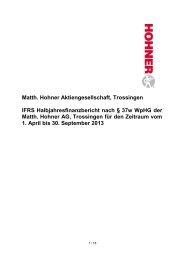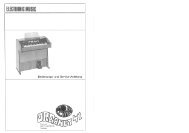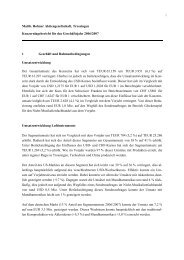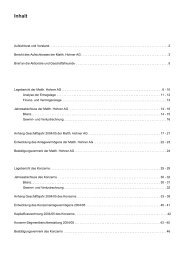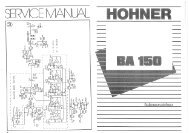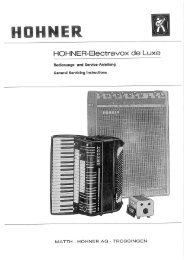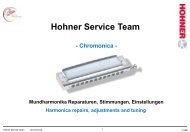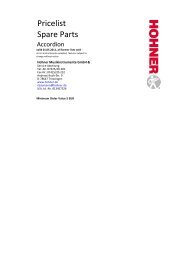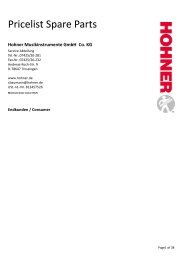Matth. Hohner AG
Matth. Hohner AG
Matth. Hohner AG
You also want an ePaper? Increase the reach of your titles
YUMPU automatically turns print PDFs into web optimized ePapers that Google loves.
Notes to the Consolidated Financial Statements for Business Year 2010/2011<br />
Loans and Receivables (LaR): After initial recognition, loans and receivables are carried solely at amortized cost.<br />
Within the group loans and receivables predominantly are of short maturity. Thus the book value of loans and<br />
receivables is an adequate approximation of their fair value. Gains and losses from the disposal or impairment<br />
of loans and receivables are recognized directly in the consolidated profit and loss statement.<br />
Cash on hand and bank balances (Cash): Cash on hand and bank deposits have a maturity of up to one year.<br />
As defined their book value equals their fair value. Their value is equal to cash and cash equivalents of the<br />
group’s cash flow statement.<br />
Financial Assets that qualify as Held for Trading (FAHfT) only exist in the form of derivative financial<br />
instruments which were designed as hedging instruments. Gains or losses from financial assets held for<br />
trading are recognized in profit or loss with the exception of anticipatory hedges with an effective hedge<br />
relationship.<br />
The Group uses derivative financial instruments such as forward exchange contracts and interest swaps<br />
in order to hedge against interest and currency risks. These derivative financial instruments are initially<br />
recognized at fair value at the time the corresponding contract is signed and subsequently measured at fair<br />
value. Derivative financial instruments are recognized as assets if their fair value is positive and as liabilities<br />
if their fair value is negative. There are no derivative financial instruments, held or issued for speculative<br />
purposes.<br />
For derivative financial instruments that do not satisfy the criteria for hedge accounting, any gains or losses<br />
from changes in their fair value are immediately recognized in profit or loss. In contrast, for derivative financial<br />
instruments that do satisfy the criteria for hedge accounting, any gains or losses from changes in fair value are<br />
either recognized in profit or loss (fair value hedge) or directly in equity (cash flow hedge).<br />
The fair value of forward exchange contracts is calculated with reference to the current forward exchange<br />
rates for contracts with similar maturity structures. The fair value of interest swap transactions is determined<br />
with reference to the market values of contracts with similar characteristics.<br />
To hedge against currency risks the group made use of derivative financial instruments for US Dollar and<br />
Japanese Yen as at March 31, 2011.<br />
HOHNER Group did not make use of the option to designate financial assets at fair value through profit or loss<br />
at initial recognition.<br />
There are no held-to-maturity financial investments.<br />
For purposes of the IFRS 7’s instructions, financial liabilities will contain in the following categories:<br />
Financial Liabilities measured at Amortized Cost (FLAC): Financial liabilities measured at their book value are<br />
carried at amortized cost observing the effective interest method after initial recognition. In the group this are<br />
especially liabilities to affiliated companies, credit institutions, and trade payables. They predominantly are of<br />
short maturity. Thus their book value is an adequate approximation of their fair value. Gains and losses are<br />
directly recognized in consolidated profit and loss statement.<br />
Financial liabilities held for trading (FLHfT): This category contains derivative financial instruments which<br />
are not part of an effective hedge relationship according to IAS 39 and for which the fair market value<br />
in subsequent measurement resulted in a negative fair value. Changes in fair market value in subsequent<br />
measurement are recognized in profit or loss with exception of hedges with effective hedge relationship. The<br />
financial instruments are measured at stock market-/fair market value.<br />
HOHNER Group did not make use of the option to designate financial assets at fair value through profit or loss<br />
at initial recognition. The Group uses derivative financial instruments such as forward exchange contracts and<br />
interest swaps in order to hedge against interest and foreign exchange risks, especially those from operating<br />
activities. There are no derivative financial instruments, held or issued for speculative purposes. Derivative<br />
financial instruments are initially recognized at fair value at the time the corresponding contract is signed and<br />
subsequently measured at fair value. Derivative financial instruments are recognized as assets if their fair value<br />
is positive and as liabilities if their fair value is negative.<br />
Notes to the CoNsolidated FiNaNCial statemeNts Notes to the CoNsolidated FiNaNCial statemeNts<br />
77



